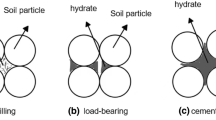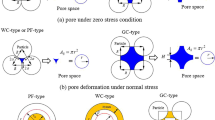Abstract
In this paper, many numerical simulation tests of biaxial compression by the discrete element method (DEM) are carried out on the hydrate-bearing sediments. It should be noted that the flexible particle membrane boundaries are used in the DEM simulation tests instead of the rigid wall, which is more reasonable to reproduce the real failure mode of hydrate-bearing sediments. The mechanical properties and failure process of hydrate-bearing sediments during loading are analyzed from the macro and micro perspectives. According to the simulation test results, the formula for calculating the initial elastic modulus of hydrate-bearing sediments is established, through which the initial elastic modulus under specific conditions is determined. In addition, a statistical damage constitutive model, which is based on Weibull distribution and Drucker-Prager strength criterion, is developed to predict the micro mechanical behaviors of hydrate-bearing sediments. The parameters in the constitutive model are determined by the extreme value method. The results predicted by the constitutive model are in good agreement with the test results, which prove that the constitutive model is reasonable.


















Similar content being viewed by others
REFERENCES
S. Kimoto, F. Oka, and T. Fushita, “A chemo-thermos-mechanically coupled analysis of ground deformation induced by gas hydrate dissociation,” Int. J. Mech. Sci. 52, 365–376 (2010). https://doi.org/10.1016/j.ijmecsci.2009.10.008
K. P. Lijith, B. R. C. Malagar, and D. N. Singh, “A comprehensive review on the geomechanical properties of gas hydrate bearing sediments,” Mar. Petrol. Geol. 104, 270–285 (2019). https://doi.org/10.1016/j.marpetgeo.2019.03.024
K. You, P. B. Flemings, A. Malinverno, et al., “Mechanisms of methane hydrate formation in geological systems,” Rev. Geophys. 57, 1146–1196 (2019). https://doi.org/10.1029/2018RG000638
J. Mountjoy, I. Pecher, and S. Henrys, “Shallow methane hydrate system controls ongoing, downslope sediment transport in a low-velocity active submarine landslide complex, Hikurangi Margin, New Zealand,” Geochem. Geophys. Geosyst. 15, 4137–4156 (2014). https://doi.org/10.1002/2014GC005379
A. Klar, K. Soga, and M. Y. A. Ng, “Coupled deformation–flow analysis for methane hydrate extraction,” Geotech. 60, 765–776 (2010). https://doi.org/10.1680/geot.9.P.079-3799
M. Sanchez, X. Gai, and J. C. Santamarina, “A constitutive mechanical model for gas hydrate bearing sediments incorporating inelastic mechanisms,” Comput. Geotech. 84, 28–46 (2017). https://doi.org/10.1016/j.compgeo.2016.11.012
K. Miyazaki, N. Tenma, K. Aoki, et al., “A nonlinear elastic model for triaxial compressive properties of artificial methane-hydrate-bearing sediment samples,” Energies 5, 4057–4075 (2012). https://doi.org/10.3390/en5104057
Y. C. Song, Y. Zhu, W. Liu, et al., “The effects of methane hydrate dissociation at different temperatures on the stability of porous sediments,” J. Petrol. Sci. Eng. 147, 77–86 (2016). https://doi.org/10.1016/j.petrol.2016.05.009
S. Uchida, X. G. Xie, Y. F. Leung, et al., “Role of critical state framework in understanding geomechanical behavior of methane hydrate bearing sediments,” J. Geophys. Res. Sol. Earth 121, 5580–5595 (2016). https://doi.org/10.1002/2016JB012967
E. L. Wu, H. Z. Wei, R. T. Yan, et al., “Constitutive model for gas hydrate-bearing sediments considering damage,” Rock. Soil. Mech. 31, 3045–3050 (2012).
E. L. Wu, H. Z. Wei, H. Z. Wei, et al., “A statistical damage constitutive model of hydrate- bearing sediments,” Rock. Soil. Mech. 34, 60–65 (2013). https://doi.org/10.16285/j.rsm.2013.01.012
R. T. Yan, W. Y. Liang, C. F. Wei, et al., “A constitutive model for gas hydrate-bearing sediments considering hydrate occurring habits,” Rock. Soil. Mech. 38, 10–18 (2017). https://doi.org/10.16285/j.rsm.2017.01.002
X. H. Zhu, H. W. Sun, J. Z. Zhao, et al., “Damage constitutive model of equivalent variable elastic modulus for gas hydrate sediments,” Acta. Petrol. Sin. 40, 1085–1094 (2019). https://doi.org/10.7623/syxb201909006
F. Wang, Z. Wang, D. Zhang, et al., “Statistical damage constitutive model based on self-consistent Eshelby method for natural gas hydrate sediments,” Energy Sci. Eng. 9, 2079–2098 (2021). https://doi.org/10.1002/ESE3.968
J. Brugada, Y. P. Cheng, K. Soga, et al., “Discrete element modelling of geomechanical behaviour of methane hydrate soils with pore-filling hydrate distribution,” Granul. Matter. 12, 517–525 (2010). https://doi.org/10.1007/s10035-010-0210-y
H. Wang, Y. Chen, B. Zhou, et al., “Investigation of the effect of cementing ratio on the mechanical properties and strain location of hydrate-bearing sediments by using DEM,” J. Nat. Gas. Sci. Eng. 94, 104123 (2021). https://doi.org/10.1016/J.JNGSE.2021.104123
J. W. Jung, J. C. Santamarina, and K. Soga, “Stress-strain response of hydrate-bearing sands: Numerical study using discrete element method simulations,” J. Geophys. Res. Sol. Earth 117, B04202 (2012). https://doi.org/10.1029/2011JB009040
J. W. Liu, X. S. Li, X. Kou, et al., “Analysis of hydrate heterogeneous distribution effects on mechanical characteristics of hydrate-bearing sediments,” Energy Fuels 35, 4914–4924 (2021). https://doi.org/10.1021/ACS.ENERGYFUELS.0C04388
A. Masui, H. Haneda, Y. Ogata, et al., “Effects of methane hydrate formation on shear strength of synthetic methane hydrate sediments,” in Proceedings of The Fifteenth (2005) International Offshore and Polar Engineering Conference, Seoul, South Korea, 2005, Ed. by J. S. Chung, S. W. Hong, J. Koo, et al. (Seoul, 2005), pp. 364–369.
S. Uchida, S. Kenichi, and Y. Koji. “Critical state soil constitutive model for methane hydrate soil,” J. Geophys. Res. Sol. Earth 117 (B3), 1–13 (2012). https://doi.org/10.1029/2011JB008661
A. Masui, H. Haneda, Y. Ogata, et al., “Mechanical properties of sandy sediment containing marine gas hydrates in deep sea offshore Japan,” in Proceedings of the Seventh ISOPE Ocean Mining Symposium, Lisbon, Portugal, 2007, Ed. by J. S. Chung and T. Komai (Lisbon, 2007), pp. 53–56.
Y. H. Shi, X. H. Zhang, X. B. Lu, et al., “Experimental study on the static mechanical properties of hydrate-bearing silty-clay in the south China sea,” Lixue. Xuebao. 47, 521–528 (2015). https://doi.org/10.6052/0459-1879-14-424
H. W. Zhang, Y. F. Cheng, M. L. Li, et al., “Tests on rock mechanics and establishment of strength criterion for gas hydrate reservoirs in the northern shallow sediments of South China Sea,” China Offshore Oil Gas 29, 115–121 (2017). https://doi.org/10.11935/j.issn.1673-1506.2017.06.015
M. L. Li, Study on Physical and Mechanical Characteristics of Multi-Type Natural Gas Hydrate- Bearing Sediments in the South China Sea (China University of Petroleum, Qingdao, 2016).
X. J. Sun, Y. F. Cheng, and L. D. Li, “Triaxial compression test on synthetic core sample with simulated hydrate bearing sediments,” Petrol. Dill. Tech. 40, 52–47 (2012). https://doi.org/10.3969/j.issn.1001-0890.2012.04.011
J. H. Choi, S. Dai, J. S. Lin, et al., “Multistage triaxial tests on laboratory-formed methane hydrate-bearing sediments,” J. Geophys. Res. Sol. Earth 123, 3347–3357 (2018). https://doi.org/10.1029/2018JB015525
J. Lemaitre, “How to use damage mechanics,” Nucl. Eng. Des. 80, 233–245 (1984). https://doi.org/10.1016/0029-5493(84)90169-9
Author information
Authors and Affiliations
Corresponding author
About this article
Cite this article
Chen, Y., Zhou, B., Zhang, C. et al. A Statistical Damage Constitutive Model of Hydrate-Bearing Sediments Based on DEM Tests with Flexible Membrane Boundaries. Mech. Solids 58, 1667–1689 (2023). https://doi.org/10.3103/S0025654423600605
Received:
Revised:
Accepted:
Published:
Issue Date:
DOI: https://doi.org/10.3103/S0025654423600605




